In our last installment of Technically Speaking, we discussed the current bullish trend and our price target of 3000 by year end. To wit:
Regardless of the reasons, the breakout Friday, with the follow through on Monday, is indeed bullish. As we stated repeatedly going back to April, each time the market broke through levels of overhead resistance we increased equity exposure in our portfolios. The breakout above the January highs now puts 3000 squarely into focus for traders.
Early last week, we used that pullback to support to add equity exposure to portfolios. Again, we are moving cautiously. With the trend of the market positive, we realize short-term performance is just as important as long-term. It is always a challenge to marry both. As I noted on Saturday:
While we are long-biased in our portfolios currently, such doesn’t remain there is no risk to portfolios currently. With ongoing ‘trade war’ rhetoric, political intrigue at the White House, and interest rates pushing back up to 3%, there is much which could spook the markets over the next 45-days.
Well, yesterday, the markets got spooked as the President once again ramped up the rhetoric on China instituting another $200 billion in tariffs and threatening $200 billion more if “China retaliates.”
With a double top in place, there is now a building level of overhead resistance traders will have to deal with to move the markets higher. It will be important for the market to consolidate the recent advance above current support. A break of support will likely lead to a test of critical support around 2800.
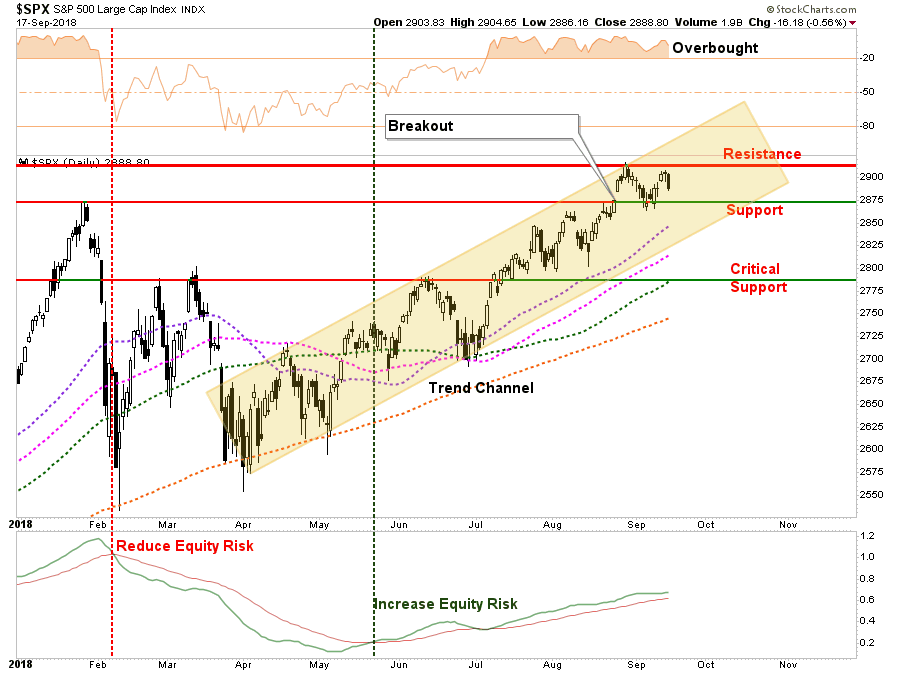
While a sell-off was not unexpected, we continue to undertake prudent steps in our overall portfolio management process:
- Stop-loss levels have been moved up to recent lows.
- A couple of defensive positions were added to equity portfolios.
- With yields back to 3% on the 10-year Treasury, we will also look to add additional exposure to our bond holdings. The biggest gains over the next 5-years will come from Treasury bonds versus stocks.
Breadth has been weak as of late. Leadership in the FANG’s has fallen off with even the mighty Amazon.com (NASDAQ:AMZN) falling sharply yesterday and breaking its recent uptrend joining the rest of the crowd. Small-cap outperformance has weakened as well.
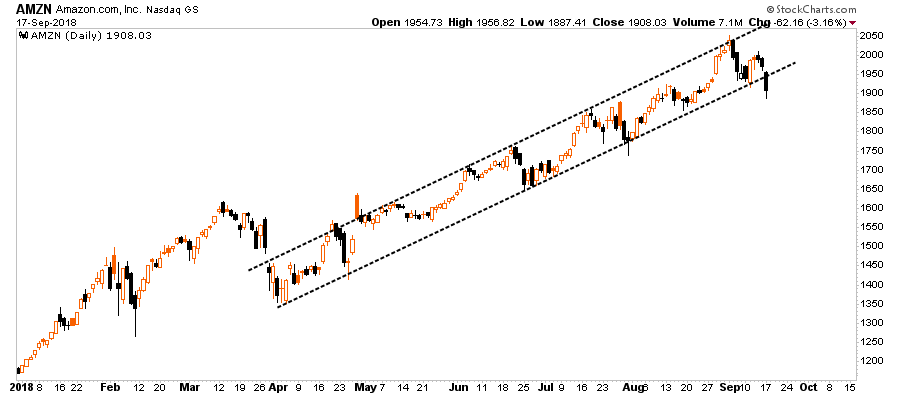
While the trend of the domestic markets remain bullish, which is why we are domestic-focused in portfolios right now, the rest of the world isn’t.
The Warning From The World
One of the biggest concerns I have addressed previously is the divergence of global markets from the U.S. This suggests two things:
- Economic strength in the U.S. has been a function of short-term stimulus (ie. Natural disasters, tax cuts, and massive increases in Federal spending) rather than more sustainable long-term factors.
- Rising interest rates and “trade wars” are having an impact that will cycle back to the U.S.
Around the globe, sell signals abound.
In the United Kingdom, the 50-day moving average has crossed below the 200-day moving average which is viewed as an important warning. Furthermore, despite the S&P 500 being up almost 9% year-to-date, the U.K. is down -5%.
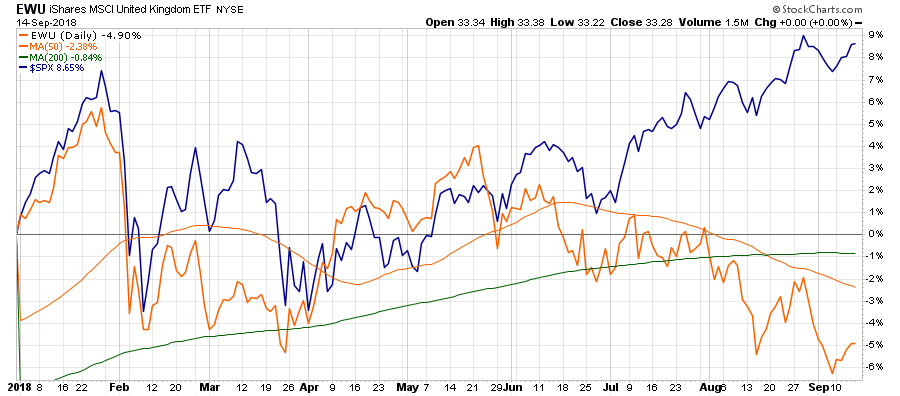
Likewise, Japan has also registered a similar warning despite the Government regularly buying equities directly in the market through their “QE” program.
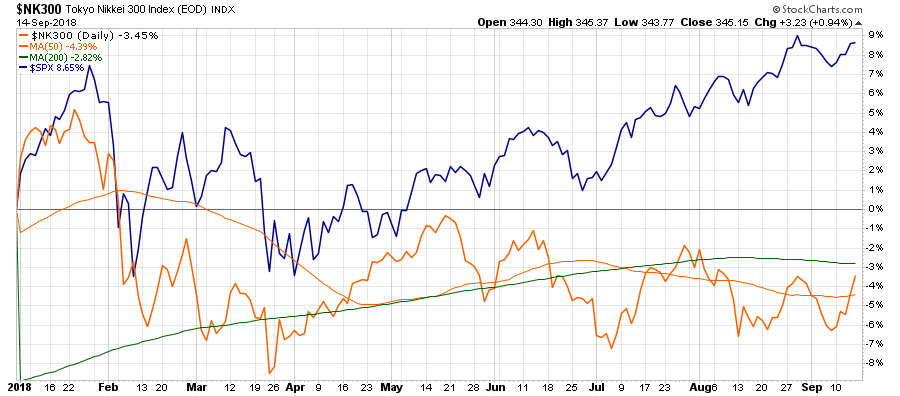
Not surprisingly, with Trump’s “trade war” being levied directly at them, China has slumped markedly year-to-date pushing a near 10% decline since June.

South Korea, where exports are a strong leading economic indicator for the U.S., has also slumped -6% since June as trade woes continue.

Germany, a leading exporter of luxury automobiles, also suggests something has turned for the worse since the beginning of the year.

But it is not just these selected countries which have all signaled a change in their current trend, but as we noted previously, it is in the combined emerging market and industrialized international countries globally.
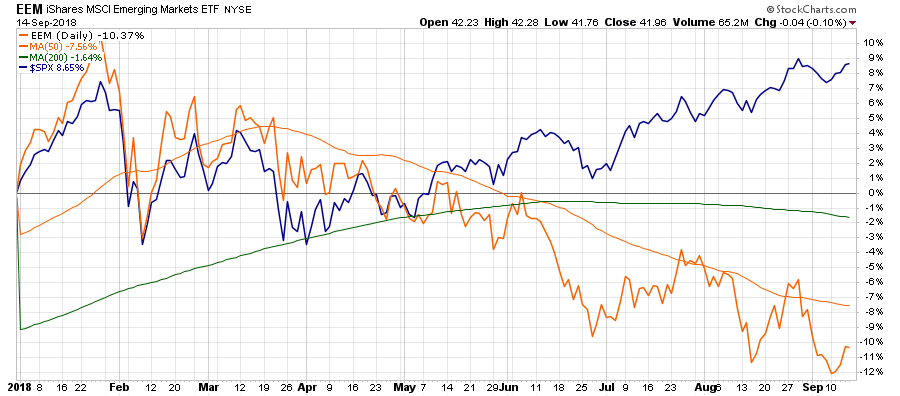
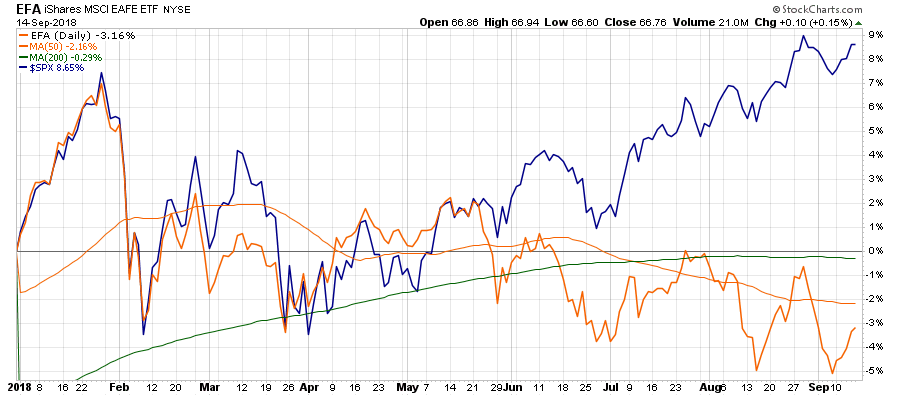
Since the turn of the century these global signals have been important warnings for the domestic markets. In fact, going back to 1998, when momentum and moving average crossovers have combined with more extreme overbought conditions (relative strength index above 70), the domestic markets have been negatively impacted.
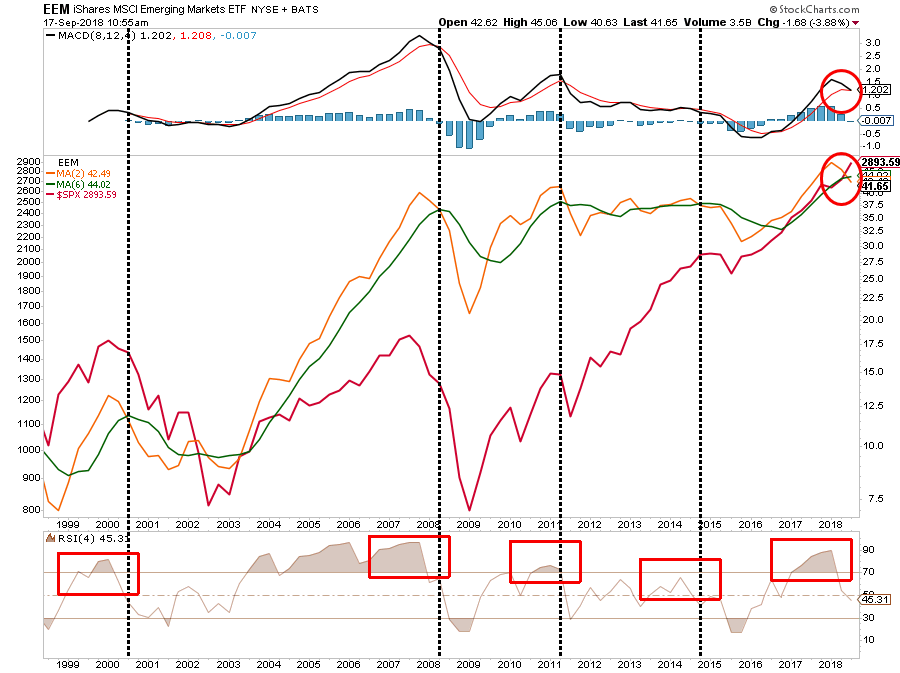
The same analysis holds true for industrialized international markets as well. Again, we see that when these quarterly signals are combined with overbought conditions, the domestic markets have eventually been negatively impacted.
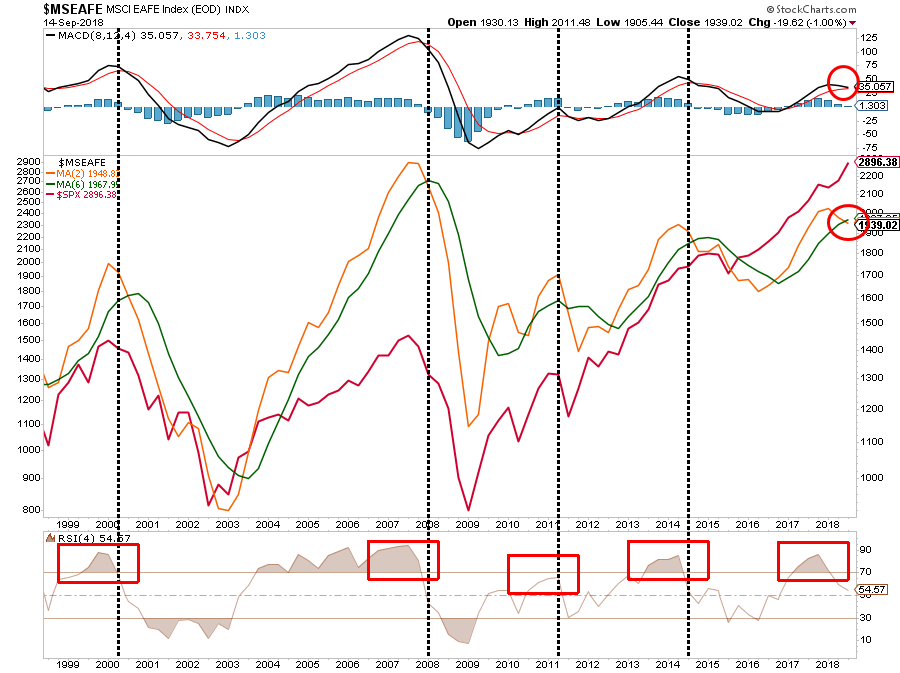
While the U.S. can certainly remain detached from the world in the short-term due to fiscal stimulus, the “demand pull” from stimulus fades rather quickly and leaves a consumption “void” in the future.
The point here is simple.
While bullish sentiment very much controls the short-term trend and direction of the market, in which we must participate, the longer-term dynamics are getting more cloudy. As Barron's recently noted:
These financial indicators don’t yet signal an impending recession. Does that mean the message of the flattening yield curve should be ignored? At your peril.
The Economic Cycle Research Institute’s array of indicators point to a ‘stealth cyclical slowdown,’ according to Lakshman Achuthan, its co-founder. The growth rate of the ECRI Weekly Leading Index is unambiguously downward, reaching zero in its latest reading.
And in contrast to the latest robust GDP readings, ECRI’s broader U.S. Coincident Index is below last October’s peak. ‘That’s pretty remarkable because we’ve had massive fiscal stimulus on top of an energy production boom,’ he writes in an email.
Bottom line, ECRI’s Weekly Leading Indicator is ‘telling us in no uncertain terms that economic growth will ease in coming months,’ but not fall into a recession, Achuthan concludes. That’s consistent with the message of the yield curve, which may explain why I’m obsessed with it.”
I agree. The international slowdown is becoming increasingly obvious. The most popular U.S. measures seem to present more of a mixed bag. And, as we pointed out late last year, something the bond market has already been sniffing out.
There is a growing risk of a negative shock caused by rising rates. We have seen some early warnings from international bond market episodes, currency crashes, and declining asset prices. However, these issues will ultimately extend contaminate the entire globe. This is a risk that is vastly under-appreciated by domestic investors currently which have become extremely complacent and overly allocated to equities.
Goldman Sachs (NYSE:GS) laid out three reasons in this regard (courtesy of Zerohedge):
- First, the real rate of return available on “safe” US assets is rising, both in absolute terms and relative to non-US markets. As the rate of return on “cash” rises, the appeal of risky assets falls. The low level of real rates over most of the post-crisis period set a very low bar for risky assets. That bar is now rising, and as long as the US economy continues firing on all cylinders, the bar will continue to rise.
- Second, the equity risk premium (ERP), credit risk premium (CRP), and bond risk premium (BRP) – have been compressing over the course of this expansion. While the compression of risk premia shown in this exhibit is typical over the course of most business cycle expansions, “but in this cycle, our measures of ERP and BRP, in particular, appear to have fallen to unusually low levels.”
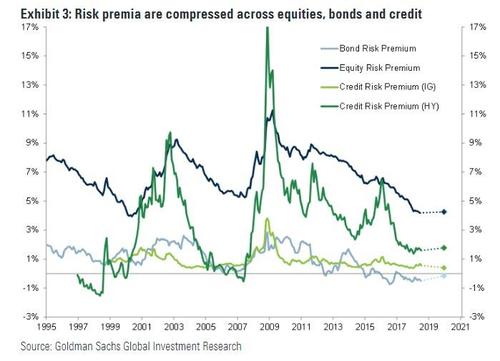
- Third, risk itself is rising as the risk of macro imbalances (most visibly in labor markets) creeps steadily higher. Thus, the low-risk premia available on most risky assets is steadily becoming even less appealing as the cycle ages.
The era of growth fueled by macroeconomic stimulus, with no apparent adverse side effects such as high inflation, appears to be drawing to an end. In the absence of deep-rooted reforms to improve productivity, the growth spurts in both emerging and major international economies is coming to an end.
With surging deficits in the U.S., mounting public debt, and unfavorable demographics, not to mention rising external debt levels of some emerging market economies, these risk factors reduce policy space for responding to exogenous macroeconomic shocks.
There are a multitude of risks on the horizon, from geopolitical, to fiscal, to economic which could easily derail growth if policymakers continue to count on the current momentum continuing indefinitely. The dependency on liquidity, interventions, and debt has displaced fiscal policy that could support longer-term economic resilience.
This doesn’t mean the markets will “mean revert” tomorrow, but it does suggest that there is a rising risk of disappointment for economic growth, and ultimately earnings, in the future.
